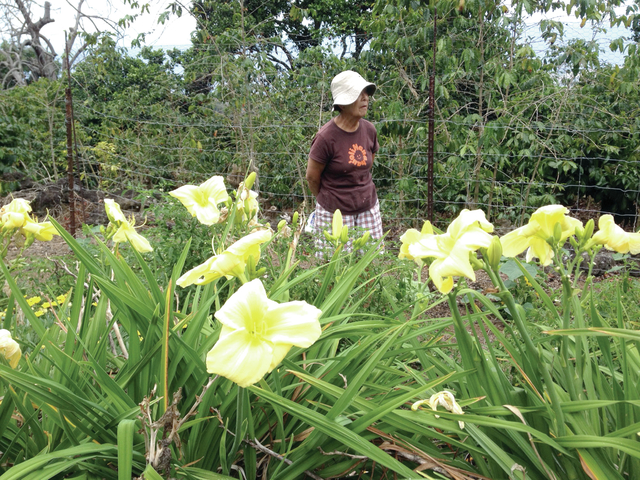Here in Hawaii, Memorial Day has long been associated with cut flowers, lei and colorful foliage for decorating the graves of our military personnel who died while serving. ADVERTISING Here in Hawaii, Memorial Day has long been associated with cut
Here in Hawaii, Memorial Day has long been associated with cut flowers, lei and colorful foliage for decorating the graves of our military personnel who died while serving.
Memorial Day was first known as Decoration Day and began soon after the Civil War ended to honor Union and Confederate soldiers killed during the war. Graves were decorated with the American flag and the best, most beautiful flowers. Since World War I, Memorial Day included honoring all those soldiers who perished while serving. The original day of observance was set as May 30 as it was thought flowers would be in bloom in every state. Today, Memorial Day honors all those individuals who met the ultimate sacrifice while serving in any branch of the armed services.
As flowers go, lilies have long been associated with the grieving that comes from remembering the departed. Perhaps it’s because of the simple elegance of their pure white flowers or symmetrical form, or the sight of somber pastel shades that convey a sense of peace and tranquility.
While many flowers are referred to as lilies, the lily family, Liliaceae, currently includes 15 genera and about 600 species. The most common lilies found in Hawaii are the Easter lily, tiger lilies and the tulip, all of which are commercially grown and timed to bloom for a specific occasion.
Other flowers commonly called lilies — such as water lily, fire or gloriosa lily, calla lily and daylily — are not true lilies. Part of this confusion is the result of past taxonomic classification where the lily family was a catch-all group of plants having more or less similar characteristics. At its largest, the lily family represented several hundred genera and thousands of species. At that time, the lily family included plants such as aloe, asparagus, onions, agapanthus, lirope, cordyline (ti leaf), dracaena, yucca and sansevieria. Therefore, it is important to remember groupings change from time to time and depend on outdated information that doesn’t provide the true story.
Lilies in general are native to temperate and subtropical regions on all continents in the northern hemisphere. Some of the common characteristics for members of the lily family are large, fragrant flowers, with sepals and petals arranged in three’s. The sepals and petals normally are undifferentiated in shape and color from each other, giving it the appearance of having six petals.
Leaves are long and narrow with parallel veins and arranged in an alternating pattern up the stem or in a rosette cluster at soil level. Most have bulbs comprised of scales or rhizomes (underground stems) that act as resting bodies during dormancy and are used for propagation.
Plants normally are perennial, dying back to the bulb or rhizome annually, and range in size from a couple of feet to more than 6 feet tall. Another common characteristic is the presence of contractile roots that function to pull the bulb deeper into the soil; hence, bulbs are naturally found growing deep in the soil.
Because of the lack of cold weather to fulfill dormancy requirement in Hawaii, true lilies normally are planted as annuals after the bulbs are vernalized either by the company that sold them or by you in your refrigerator. Plant bulbs to a depth two times the height of the bulb — shallower is better than too deep. As mentioned, lilies will pull themselves to the proper depth.
Lilies enjoy sunny to lightly shaded locations where the soil is well drained but retains consistent moisture.
A better choice for Hawaiian gardens are the daylilies, Hemerocallis sp., which are far more adaptable to Hawaiian gardens than true lilies.
As the name implies, flowers last only for a day, but the profusion of flowers tend to ensure a new bloom the following day. Another good sign is even its scientific name, which refers to beauty and day.
Daylilies come in a wide variety of flower sizes, colors and color patterns. Estimates for the number of varieties run in the tens of thousands, with some listing more than 30,000 worldwide.
In Hawaii, daylilies can be transplanted into the garden at any time of the year.
Daylilies will grow well with little care and are adaptable to many soil types, but they do best in slightly acidic soils that are moist, but well drained. The plant loves deeply tilled soil with a generous heaping of well-composted manure and other organic amendments.
Daylilies form great clumps of individual plants or fans, with each producing a flower stalk. To subdivide a clump, cut or break it into small groupings with a minimum of two individual plants or fans together. Trim leaves down to about 6 inches and, using as a reference point where the root emerging from the stem, plant to a depth of 1 inch.
Fertilize according to soil test recommendation and water as needed to maintain soil moisture.
For more information about this and other gardening topics, visit the CTAHR electronic publication website at www.ctahr.hawaii.edu/Site/Info.aspx or visit any of the local Cooperative Extension Service offices around the island. Nagata can be reached via email at russelln@hawaii.edu.



